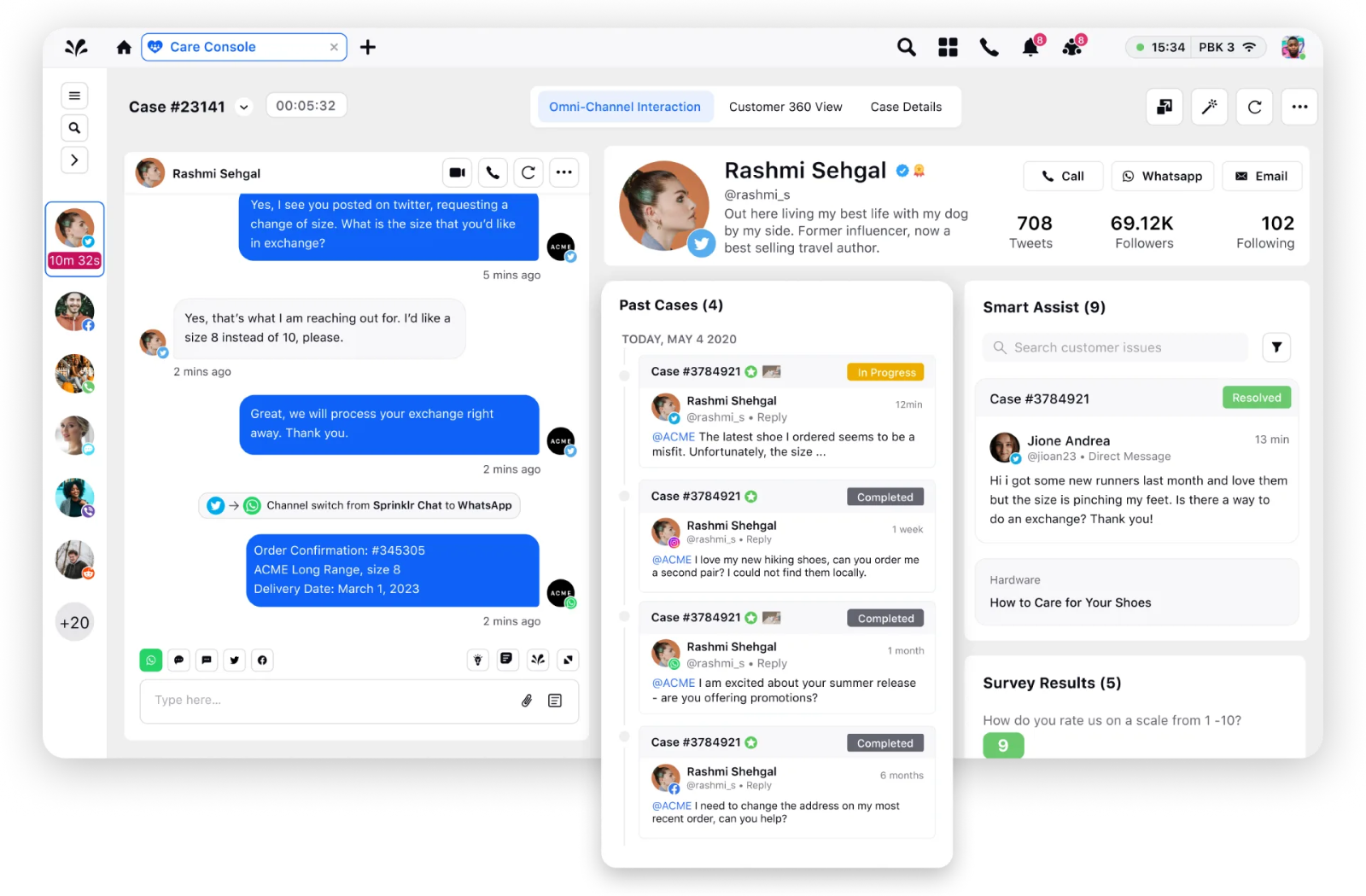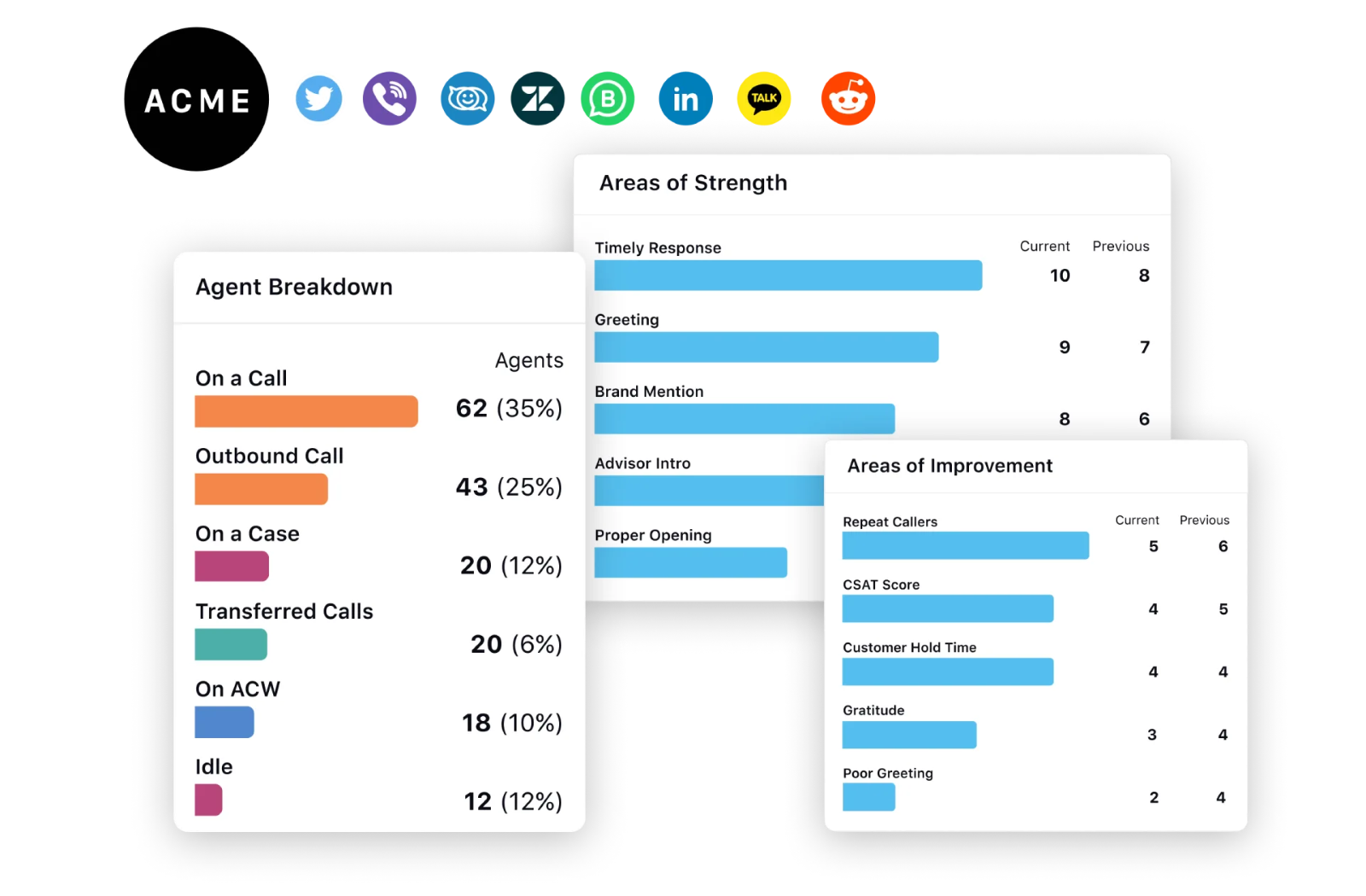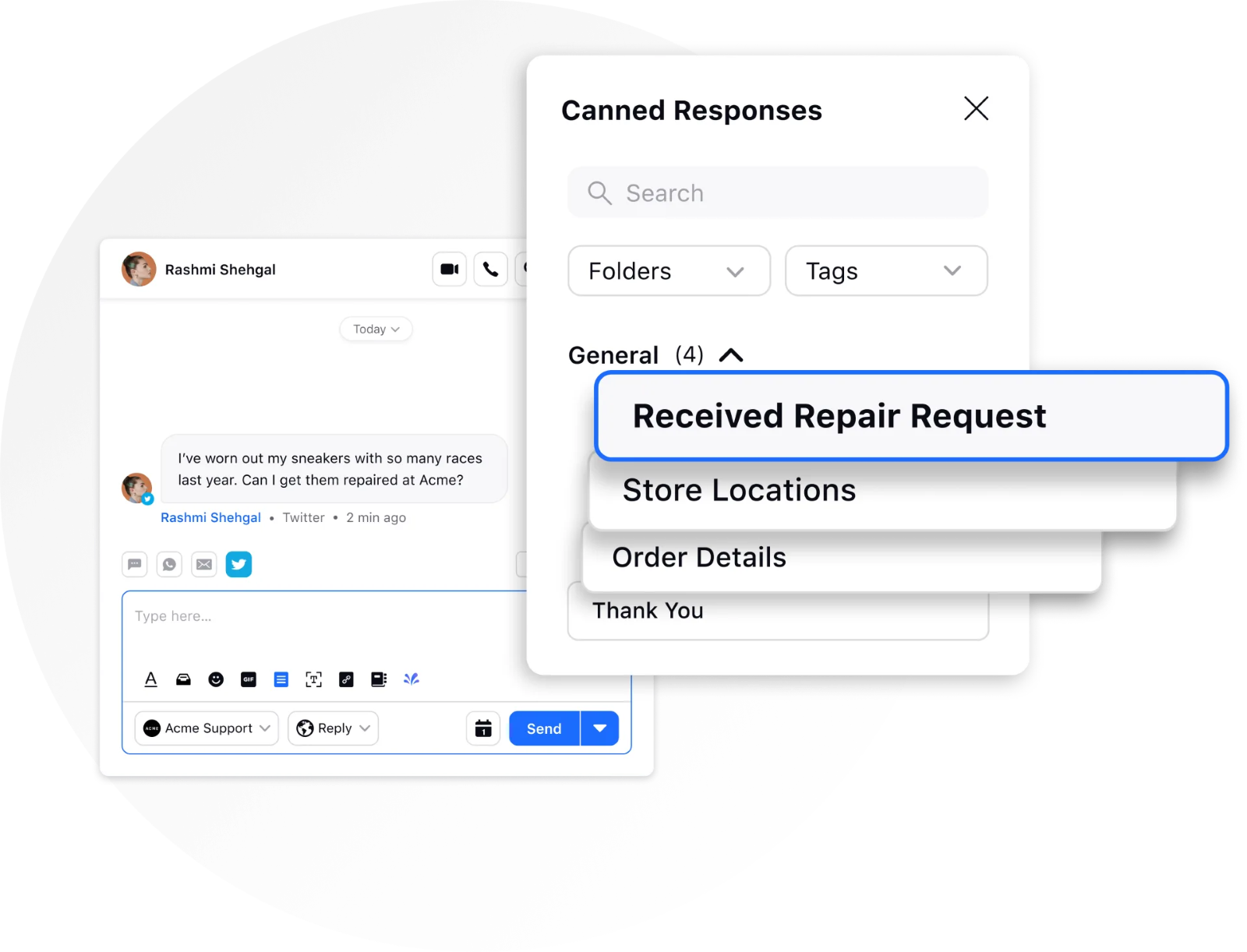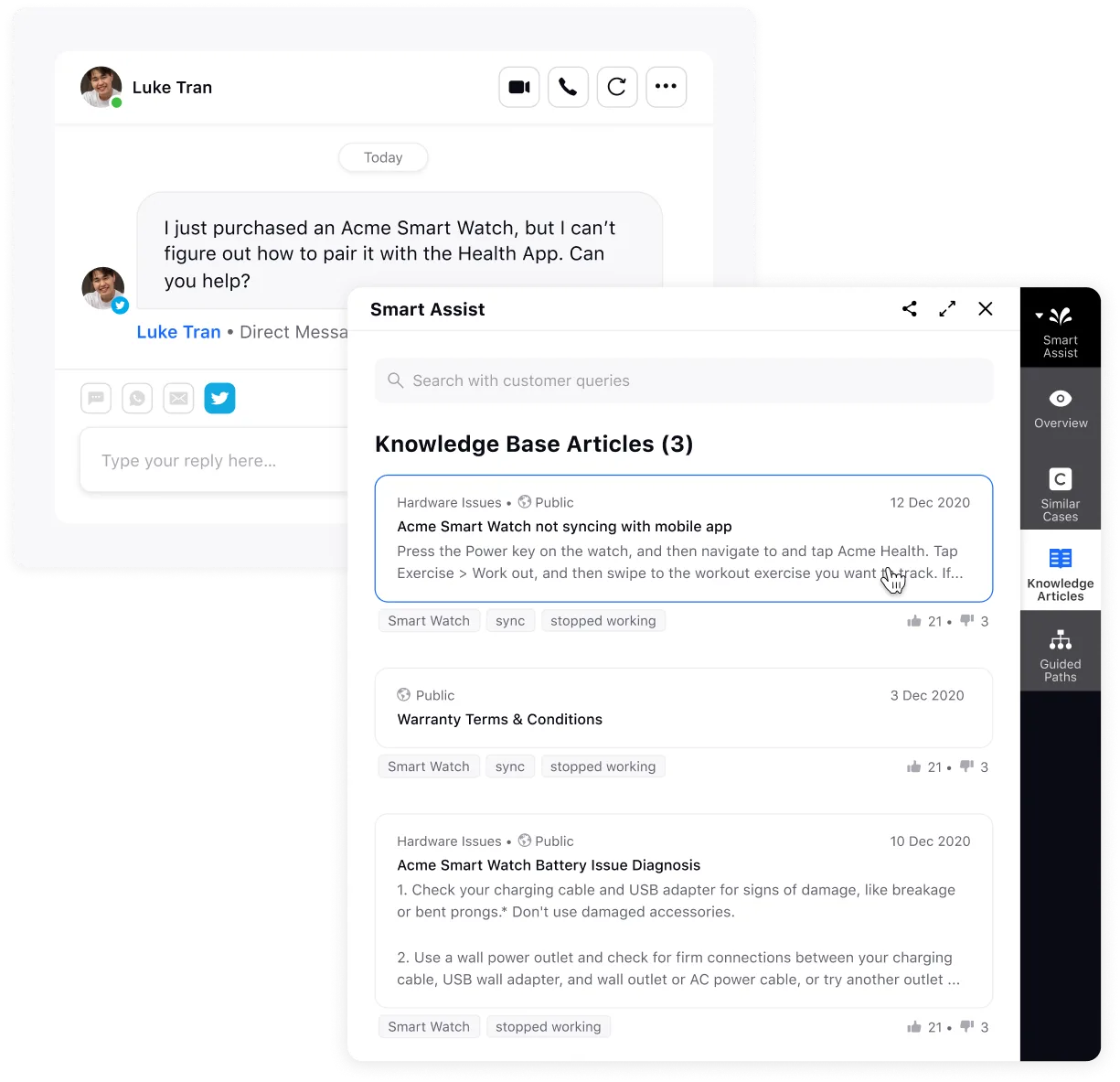What is average handle time?
Average handle time (AHT) is a metric used in contact centers to measure the average duration of a customer call interaction from the time a customer initiates a phone call to the time of final resolution — which may happen either during the call or later. The duration includes talk time, hold time, transfers, and any after-call work (ACW) that an agent must perform post-interaction to resolve the customer query.
Why is average handle time important in customer service?
AHT is an essential metric for contact center leaders to track since it indicates — and helps improve — the customer experience (CX) your contact center agents provide to your customers. Here is why you must measure your average handling time.
Meet customer expectations, enhance CX: At the end of the day, a solid AHT correlates with better customer satisfaction. The shorter it is, the more improved your CX will be. While basic chatbots are equipped well enough to handle most routine queries quickly, live chat support can improve AHT on all the other complex cases.
Drive efficiency with data: Monitoring AHT helps identify areas that need improvement in the support process. If certain areas take too long, it could indicate a need to improve the customer effort score or more effective departmental communication.
Strategize resource allocation: A variance in AHT for support requests across products or on specific channels indicates where to prioritize resources. Longer AHTs might mean you need more staff, integrate specific tools or refine product messaging to reduce complexities.
Track agent productivity: Regularly tracking AHT can highlight differences in agent performance. This information is useful for setting performance standards, offering targeted customer service coaching and adjusting work schedules.
How to calculate average handle time [+ Formula]
Before calculating AHT for your contact center, you need to gather the following data points:
Total talk time: the amount of time your agent spends on a customer interaction
Total hold time: the amount of time your agent leaves a customer on hold
After-call work (ACW): ACW is the amount of time one or more agents spend on post-interaction tasks — like updating systems and records, documenting the reason for contact and outcome, escalating complaints, or scheduling follow-up actions
Total number of phone calls: the number of calls handled by the agent to resolve an issue
The formula to calculate average handle time is as follows.
Average Handle Time = (Talk time + Total hold time + After-call work)/Total number of calls handled
Note: You can calculate the AHT for different channels — such as email, messaging and live chat — using the same formula, but without factoring in the total hold time.
Whether you want to calculate AHT for each communication channel, agent, department or organization, you can use Contact Center as a Service (CCaaS) to do the hard work. CCaaS solutions can compute AHT and other critical metrics by pulling in support-related data from all of your integrated channels and creating visual dashboards and reports.
What is a good AHT?
A good AHT is a balance between efficient and quality customer service, not just a numerical target. Determining the "ideal" AHT is an intricate process and relies on a variety of factors:
Industry benchmarks: AHT varies across industries. For instance, technical support might naturally have a longer AHT than basic customer inquiries in retail. Knowing your industry standard helps set a realistic starting point.
Organizational structure: A centralized team might resolve issues faster due to streamlined communication. Conversely, geographically diverse teams or ones with multiple hierarchies could have a lengthier AHT.
Quality vs. speed: While a low AHT is great, it shouldn’t come at the expense of service quality. Rushed interactions might harm satisfaction scores. Regularly cross-referencing AHT with customer feedback can help gauge if resolutions are adequately thorough.
💡Pro tip: You can use a conversational analytics tool to automatically gauge negative sentiment and catch possible drops in CSAT scores. Create alerts for CX issues and mitigate poor experiences in time.

AHT industry benchmarks
Research by Call Center Helper reveals the AHT benchmarks for some industries below:
Sector | Average Handle Time (in Minutes) |
Telecommunications | 8.8 |
Retail | 5.4 |
Financial Services | 4.7 |
Business & IT services | 4.7 |
7 ways to reduce average handle time
Before you think of ways to improve your AHT, you need to factor in other metrics like CSAT (customer satisfaction score) and NPS (net promoter score). If the net result of these three metrics is not as expected or lower than industry standards, follow these tips:
1. Diagnose the root cause for longer AHT
Identifying the root cause of longer AHT starts with 100% call coverage. Ensure that you monitor every interaction. Use speech analytics to uncover common observable factors that impact AHT — including dead air, supervisor escalations and hold-time violations.
Integrating sentiment analysis can help identify recurring customer grievances, allowing you to refine agent scripts or create specific standard operating procedures (SOPs) to handle volatile callers and situations.
2. Stay on top of your team's performance metrics
Managers should keep a close eye on team performance and contact center metrics because each metric affects AHT.
Supervisors should continuously monitor metrics affecting AHT like:
Calls missed
Calls declined
Average time to answer
Transfers accepted
Average talk time
Average wait time
Longest wait time
Average hold time
Exceeded queue wait
Callers abandoned in the queue

3. Train agents to optimize AHT
Training agents is foundational for reducing AHT and ensuring consistent CSAT. Hold micro-training sessions that include tactics to coach agents to reduce AHT. The sessions can focus on customer empathy, critical agent soft skills and de-escalation tips. Here's a deeper dive into effective training strategies:
Scenario-based learning: Equip agents with hyper-specific scenario training for situations they frequently encounter.
Knowledge matrix: Create a matrix cross-referencing agent expertise with specific challenges, highlighting areas for focused training.
Case study analysis: Regularly review successful interactions, drawing insights into best practices and strategies to emulate.
Peer-to-peer coaching: Let top-performing agents get involved in customer service coaching, sharing tips and insights to help the whole team get better.
4. Empower agents with AI-powered assist tools
Strengthen your agents with assist tools can dramatically cut down AHT. These tools can provide:
Quick, on-brand answers: Store pre-set, brand-aligned responses for routine questions, letting agents answer promptly and consistently.
AI-aided responses: AI analyzes ongoing chats to adapt agent scripts to ensure they are always guided on the next best action, reducing the decision-making time.
Relevant past case access: Highlight similar past issues or related knowledge base articles to speed up query resolutions. This repository ensures agents always have the best resources at their fingertips.

5. Equip agents with data and context
Giving agents a single console with a complete view of all customer service channels makes their job easier. They can see past chats, buying details, and customer likes without switching screens.
An integrated space with a 360-degree customer view feeds them with case and profile notes to help them pick up customer conversations where they left off. This eradicates the age-old issue of customers having to reiterate their concerns when they hop between channels.
Moreover, with real-time data synchronization, agents can address concerns proactively, anticipate needs and cut down on the time spent per call or chat.

6. Expand self-service and knowledge base
Create an accessible, dynamic internal knowledge base to guide agents. Parallelly, empower your audience with customer self-service — including a public knowledge base, chatbots and FAQ sections. Immediate access to answers via these mediums can lead to fewer direct contacts and a lower AHT.

7. Automate your processes
The entire saga of delivering the right answers to customers in time involves several, independent processes. Consider automating these processes to ensure smooth resolution deliveries.
Skill-based routing: Instead of routing calls randomly, use skill-based routing to assign calls to agents based on their expertise.
Automated data retrieval: Empower agents to instantly receive all relevant customer info upon contact, cutting down manual data searches.
Queue callbacks: Instead of prolonged hold times, offer a callback system so customers get a return call when an agent is available.
Limitations of average handle time for businesses
While AHT seems fair enough to track your agent’s performance, it sometimes might fail to paint a complete picture. Here are the top three limitations of using average handle time for businesses:
1. Ignored complexity
AHT doesn't differentiate between a quick question and a complex problem.
It tends to lump together various customer inquiries, making no distinction between a two-minute password reset and a 30-minute technical troubleshooting.
By averaging these, AHT can misrepresent the time agents truly need for specific tasks. For example, addressing a product defect might take longer than handling a basic shipping query. As such, the measure can sometimes miss the nuances of the job.
To get a clearer picture, it’s crucial to create benchmarks that accurately reflect the nature of each task. The performance metric for each type of question should be adaptive and have related time standards to adhere to.
2. Sidelined customer’s perspective
Merely focusing on AHT can ignore the human element.
If a customer is distressed, they may need more reassurance and clarity, which will naturally extend the interaction time.
Insights from sentiment analysis, and in the case of phone calls, voice analytics, can help you provide a more empathetic and tailored response, rather than hurriedly trying to meet an AHT benchmark.
3. Masked underlying issues
A low AHT might seem optimal but can sometimes be deceptive.
Rushed interactions might result in unresolved issues, which only surface later as repeat calls or customer drop-offs.
Imagine a customer calling a clothing store's helpline to ask about a stain on a newly purchased white dress. The agent, aiming for a low AHT, quickly suggests a general cleaning tip and ends the call.
This contributes to a brief AHT, appearing effective.
However, the recommended cleaning method doesn't work and the stain persists.
Days later, the customer calls back, frustrated, not only about the stain but the wasted effort based on incorrect advice.
In this case, if the agent took a few extra minutes to understand the type of stain or ask about the fabric of the dress, they could have provided a more specific and likely successful solution.
It underscores that while swift responses can be beneficial, depth and accuracy are paramount.
How to enhance customer experience by optimizing average handle time
Let’s understand this with Uber’s story of getting their service train on track.
As Uber's global footprint expanded, so did its customer queries. With the pandemic slowing rides but not chatter, it faced a unique roadblock: efficiently zipping through a barrage of messages without compromising quality or safety.
This was Uber’s game plan.
Tapping into AI: Uber recognized manual triaging wouldn't cut it. They integrated AI to swiftly categorize and direct pressing issues to apt responders, ensuring quicker turnarounds.
Unified platform, centralized response: By October 2021, over 1,000 agents worldwide operated from a unified platform. Uber’s newfound integrated system ensured uniformity, reduced manual search times and facilitated more rapid responses.
Empower & engage: Uber allowed employees to pitch in on brand interactions via personal social channels, ensuring queries received timely attention, and spreading responsibility while maintaining brand tone.
The result was a smooth drive — all with the solid arsenal of Sprinklr Service. Uber slashed its first response time by 33% and reduced its AHT by a cool 90 seconds without cutting corners on quality. Uber's journey proves it: you can keep the riders and drivers happy with the right mix of tech and talent.
Just like them, you can accelerate your customer service with a personalized demo of Sprinklr!
Frequently Asked Questions
AHT measures the total time spent handling a customer interaction, including talk, hold and follow-up times. ART, on the other hand, tracks the entire duration from when a customer issue arises to its complete resolution, potentially spanning multiple contacts.
Thank you for contacting us.
A Sprinklr representative will be in touch with you shortly.
Contact us today, and we'll create a customized proposal that addresses your unique business needs.
Request a Demo
Welcome Back,
No need to fill out any forms — you're all set.


